EASTGATE SHOPPING CENTER: INDIANAPOLIS, IN
Brian Stevens' Commentary:
Posted March 16, 2005 (user submitted)
They weren't called athletic shoes or tennis shoes. Back then we called them
sneakers. And while other kids had to suffer through the long humid sixties
Indiana summers wearing lesser brands like Keds or P.F. Flyers, I was a Red Ball
Jets man.
My parents bought 'em at Wasson's department store at Eastgate Shopping
Center in Indianapolis. I still remember sitting in that shoe department,
fidgeting while the salesman sized me, wanting desperately to get the shoe thing
over with so I could get to the real fun of the day. A corned beef sandwich at
Sam's Subway Cafeteria-style Deli directly across the mall from Wasson's.
To make matters worse, the Wasson's shoe department faced the deli. As you
tried on shoes sitting next to Wasson's revolving entrance doors, you could see
Sam's out the giant display windows. And you could smell the spiced aroma of
Sam's deli meats drifting through those revolving doors with every entering
Wasson's customer. Sam's was as close to heaven as this five year old could
understand.
As for H. P. Wasson's? It was Eastgate's north anchor department store.
Eastgate was Indy's first malled shopping center. And it's original name was
simply Eastgate Shopping Center. None of that "Square" this or "Mall" that back
in 1957. We lost Wasson's in the late seventies. Eastgate lasted longer. Until
it finally gave up the shopping ghost - just before Labor Day 2004 and about
thirty years longer than most people expected it to survive.
Eastgate was built as an open-air shopping mall. Rain in spring. Humidity in
summer. Wind in fall. Snow in winter. A flat concrete common area in the mall
that hardly ever drained or dried. Waiting to see Santa in the open air of
December was always good for a week-long Christmas cold.
But if you shopped at Eastgate, you learned to put up with Indiana weather.
Only after Edward J. DeBartolo built the nearby enclosed Washington Square in
1974, did Eastgate's owner decide to cover the mall. That became the first of
many times the phrase "too little too late" was used to describe the happenings
at Eastgate Shopping Center.
Some people make the mistake of blaming Simon Property Group for Eastgate's
failure, faulting two decades of Simon ownership. Simon bought Eastgate in 1981.
The mall had already been struggling after the opening of Washington Square. By
the late seventies, DeBartolo had snagged away Eastgate's south anchor stores,
J.C. Penney and Sears Roebuck, and pretty much every other strong Eastgate
tenant - clothiers like Hudson's and Levinson's - jewelers like Goodman's and
Rost.
Simon Property Group enjoyed some previous history with Eastgate. In 1957,
Mel Simon worked as Eastgate's first leasing agent. He struck out on his own in
1959, and with his brothers built a few shopping centers, bought a few others,
and by 1996 had merged with Washington Square owner DeBartolo. (The Simon's have
also owned the NBA Indiana Pacers since 1983.) Yet by the time Mel Simon bought
Eastgate, most of the tenants he had signed back in 1957 were gone.
Simon tried to find a niche for the struggling Eastgate, renovating and
renaming the center in 1982. As Eastgate Consumer Mall - sort of an early outlet
mall concept - it signed Burlington Coat Factory to replace Wassons as the
mall's north anchor. Chicago based Goldblatt stores had bought the Wasson's
chain in the sixties, and eventually bled the chain dry - closing the chain by
the late seventies.
From 1957 on, Eastgate had two five and dimes - Woolworth and G. C. Murphy.
The Murphy store facing Shadeland Avenue closed first. Woolworth facing
Shortridge Road survived into the nineties. After closing, the Woolworth's soda
fountain was bought and relocated to the Fountain Diner near downtown
Indianapolis. As the larger Eastgate retailers like Murphy and Woolworth closed,
their large floor space remained mostly unleased.
Eastgate Consumer Mall struggled to replace the south anchors, the
side-by-side J. C. Penney and Sears Roebuck stores. Both had left for opposite
sides of Washington Square by 1982. The best Simon could find to fill their
Eastgate retail space was a cut rate discount drug store. And while some might
say that Simon's discount driven consumer mall concept was ahead of its time -
by the time outlet malls came into vogue during the nineties, it was too late
for Eastgate. The layout was dated and the structure was in poor repair.
Eastgate's time as a mall had passed. A dated original design had store
entrances to both the mall itself and to the surrounding parking lots. Most of
those parking lot entrances were bricked over in the eighties. Ironically, the
remaining open business in the Eastgate structure can now only be reached by one
of those remaining original direct to the parking lot entrances.
While many of Eastgate's early tenants had moved to Washington Square - most
of those that remained eventually left business - stores like Morrison's women's
clothing or the old Standard grocery store chain. Other chain stores like Hooks
Drugs, Tuchman's Cleaners or Roselyn's Bakery closed - directing customers to
nearby stand alone locations. Although Kittle's Furniture had opened a bargain
brand furniture store in the old Standard space, most tenants under the consumer
mall concept were small floor space mom-and-pop retailers. Hardly stores to
rebuild a strong tenant base with.
What was Eastgate's final death blow? A name associated with dead malls
everywhere. North Carolina based Haywood Whichard. Whichard bought Eastgate from
Simon in 2002 - leaving Eastgate to die. While Whichard owed the City of
Indianapolis close to a half million dollars in back property taxes, he
continued to look for a buyer. He didn't find one, and the City of Indianapolis
scheduled Eastgate for an October 2004 tax sale.
At that tax sale, Wachovia-Cust/Sass Muni V DTR bought the lien on the mall
for $1.1 million. Since then, Eastgate has been sold again. On March 8th 2005,
JTL Capital of Dallas, TX assumed ownership. The Director of Economic
Development for the City of Indianapolis has since been quoted as saying "It is
likely that the existing (Eastgate) building will come down." Although Dr. Larry
Tavel, the mall's sole remaining tenant, sounds as if he intends to stay in
place until his lease ends in 2006. Tavel is an original 1957 Eastgate tenant.
Eastgate's neighborhood is on the decline. Nearby factories have closed.
Infrastructure has gone without repair or update. Housing prices have declined.
And unlike Washington Square, Eastgate sits inside the east leg of Indy's I-465
bypass. It was inevitable that Eastgate's last name tenant - Burlington Coat
Factory - would make a 2003 move to outside that 465 loop and join the others at
Washington Square.
So what's next for the grounds of that fifties mall on the northeast corner
of Washington Street and Shadeland Avenue? Rumors about car dealers and stores
for big box retailers like Wal-Mart abound. Although Target just opened a store
at Washington Square a few years back - and Wal-Mart has a new store just east
of there. One of the strangest rumors was that of Eastgate being demolished for
a new stadium for the NFL Indianapolis Colts.
The problem with Eastgate is far bigger than the dead mall itself. The
problem is with an area of Indianapolis on the decline. Indy's first two malls
were the east side Eastgate and north side Glendale. Both malls took serious
hits from newer larger DeBartolo built properties. Yet, with help from a strong
neighborhood association and from the city of Indianapolis, the Glendale area
continues to thrive. Without similar help on the east side, whatever replaces
Eastgate is destined to find it a struggle not to fail.
Exclusive Photos:
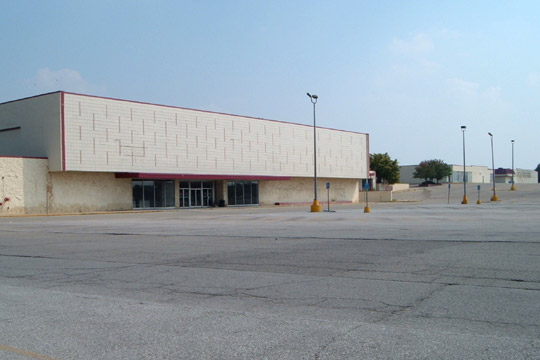
A view of the western length of the mall as it
faces Shadeland Avenue. In the foreground left is the Wasson department store
space on the mall's north end. At the far right of the picture is where the
Standard Grocery used to be on the south end.
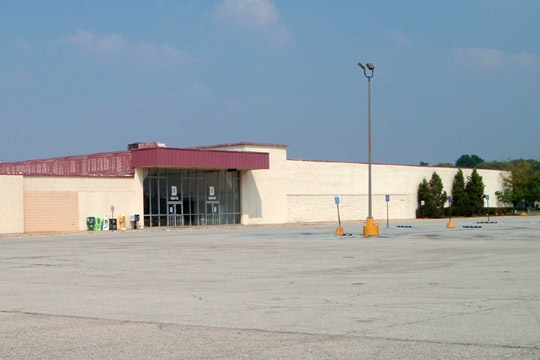
This is the mall's south end as it faces
Washington Street. To the left was the Standard grocery. To the right was J. C.
Penney.

This entrance faces Shadeland Avenue. The Scratch
and Dent outlet used to be a First Indiana bank location. I seem to recall the
empty space under the Entrance E sign was a coin operated laundry.
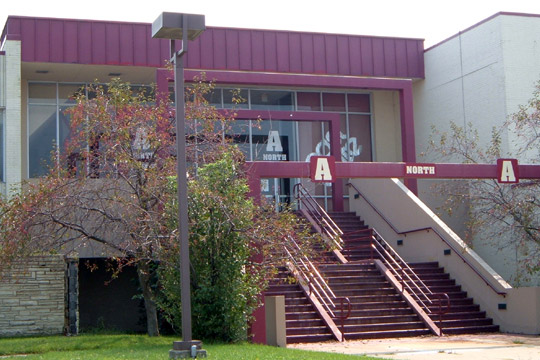
To enter the mall from the north end, you had to
climb these stairs. Fire code required the 1982 remodel to make the stairs
wider. The originals were half the width of these. They were located between the
north end of Wasson's department store and the Sam's Subway cafeteria. Most of
us entered the Wasson store from the parking lot and rode the escalator to the
mall level.

The giant picture windows were the dining area for
the Sam's Subway Cafeteria. By the late 70s, Sam's had closed and this had
become one of Indy's seedier discos. The storefronts below hosted everything
from dentists to insurance and travel agents. It appears as if the most recent
use for the space was for a church. The sign reads "Where The River Flows -
Restoration and Worship Center".
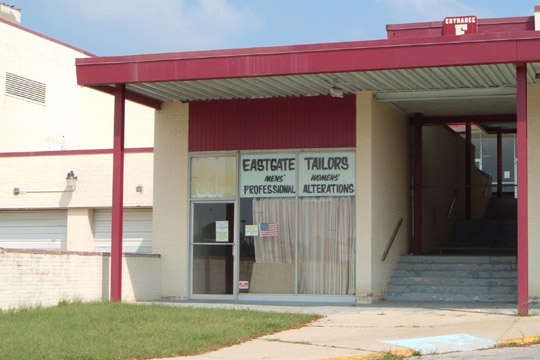
These stairs led to a mall entrance just to the
south of Wasson's. I seem to recall the tailor shop as being a shoe repair shop
at one time. Look closely and you can see the locked gated fence blocking the
stairway leading up to the mall level.
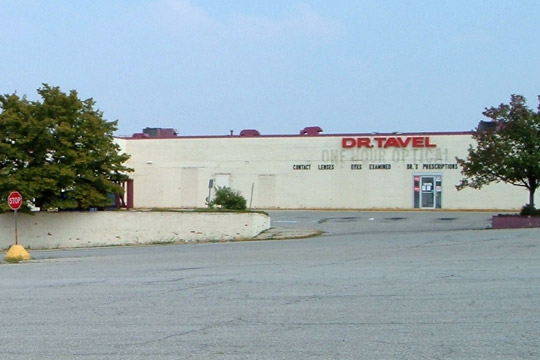
Positioned between the tailor shop and Scratch and
Dent outlet entrances is Eastgate's last remaining tenant - Dr. Tavel. Notice
the many bricked up outer entrance doors to long closed mall stores on either
side of Tavel.
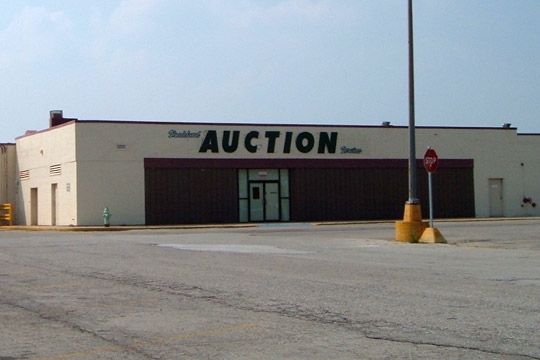
This auction house was the old Woolworth five and
dime store on theeast facing Shortridge Road side of the mall.
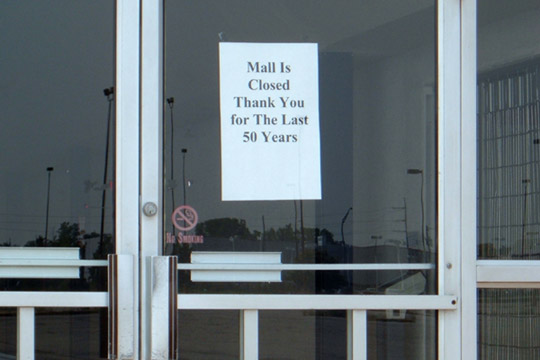
Finally a close up shot of one of the ink jet
printed "closed" signs found at every mall entrance. This is at the south end of
the mall - the entrance between the Standard and Penney stores. An out lot south
of the mall structure on Washington Street features an empty Cub food store.
(Photos taken by Brian)

